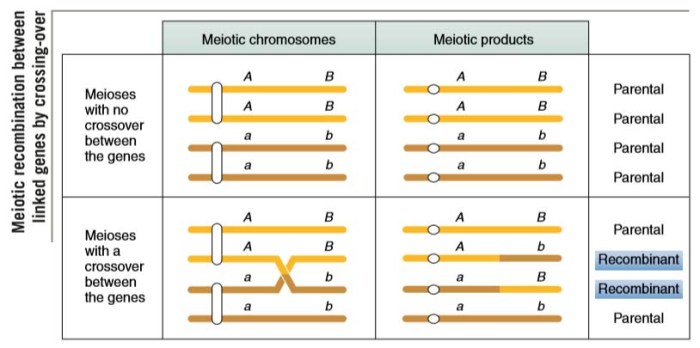Crossing over allows the reassortment of linked genes. – Crossing over, a crucial process during meiosis, allows the reassortment of linked genes, leading to genetic diversity and influencing the inheritance of traits. This process plays a pivotal role in shaping the genetic makeup of organisms, contributing to genetic variation and the evolution of populations.
During crossing over, homologous chromosomes exchange genetic material, resulting in the formation of new gene combinations. This phenomenon breaks the linkage between genes, allowing for the reassortment of alleles and the creation of novel genetic combinations.
Genetic Recombination

Crossing over is a crucial genetic recombination event that occurs during meiosis, the process of sexual reproduction. During crossing over, homologous chromosomes exchange genetic material, leading to the reassortment of linked genes.
Homologous chromosomes are pairs of chromosomes with identical gene sequences but may have different alleles. During meiosis, homologous chromosomes align and form a structure called a synaptonemal complex. At specific points along the chromosomes, crossovers occur, resulting in the exchange of genetic material between the homologous chromosomes.
The points of crossover are called chiasmata, and they are essential for genetic recombination. Chiasmata hold the homologous chromosomes together until the end of meiosis, ensuring the accurate segregation of genetic material to the daughter cells.
Reassortment of Linked Genes
Genetic linkage is the phenomenon where genes located close together on the same chromosome tend to be inherited together. Crossing over can break genetic linkage by exchanging genetic material between homologous chromosomes.
- For example, if two genes, A and B, are linked on the same chromosome, the alleles for these genes will typically be inherited together.
- However, if a crossover occurs between the genes, the alleles for gene A may be inherited with the alleles for gene B, leading to a reassortment of the linked genes.
The frequency of recombinant offspring, those that have inherited reassorted linked genes, is determined by the distance between the genes on the chromosome. The farther apart the genes, the higher the likelihood of a crossover occurring between them, and the more frequent the recombinant offspring.
Genetic Variation
Crossing over is a significant contributor to genetic diversity by creating new gene combinations. The exchange of genetic material between homologous chromosomes during crossing over results in offspring with unique combinations of alleles that may not have existed in the parents.
- For instance, if one parent has the alleles A and B for a particular gene, and the other parent has the alleles a and b, crossing over can produce offspring with the following combinations: AB, Ab, aB, and ab.
- These new gene combinationsincrease the genetic diversity of the population, providing the raw material for natural selection to act upon.
Crossing over also plays a role in the evolution of populations. By introducing new gene combinations, crossing over can create individuals with novel traits that may provide an advantage in a changing environment. Over time, these advantageous traits can become more common in the population through natural selection.
Medical Applications
Crossing over has important applications in genetic counseling and the diagnosis of genetic disorders.
- In genetic counseling, crossing over is considered when assessing the risk of inheriting genetic diseases. By analyzing the frequency of recombinant offspring in families with a history of genetic disorders, genetic counselors can provide more accurate estimates of the risk of a child inheriting the disease.
- In diagnosing genetic disorders, crossing over can help identify the specific location of a disease-causing mutation. By examining the patterns of inheritance in families, geneticists can determine if a crossover has occurred near the suspected mutation, providing valuable information for diagnosis.
- Crossing over also has potential applications in gene therapy. By manipulating crossing over events, it may be possible to introduce specific genes or correct defective genes in somatic cells, providing new therapeutic approaches for genetic disorders.
Experimental Techniques, Crossing over allows the reassortment of linked genes.
Numerous experimental techniques are used to study crossing over in model organisms.
- Cytological techniques, such as karyotyping, can visualize chromosomes and identify chiasmata, providing direct evidence of crossing over.
- Molecular markers, such as microsatellites or single nucleotide polymorphisms (SNPs), can be used to track the inheritance of specific DNA sequences across generations, allowing researchers to detect and map crossover events.
The choice of experimental technique depends on the specific research question and the organism being studied.
Popular Questions: Crossing Over Allows The Reassortment Of Linked Genes.
What is crossing over?
Crossing over is a process during meiosis where homologous chromosomes exchange genetic material, leading to the formation of new gene combinations.
How does crossing over affect genetic linkage?
Crossing over breaks the linkage between genes, allowing for the reassortment of alleles and the creation of novel genetic combinations.
What is the significance of crossing over in genetic variation?
Crossing over contributes to genetic diversity by creating new gene combinations and increasing the frequency of recombinant offspring.


